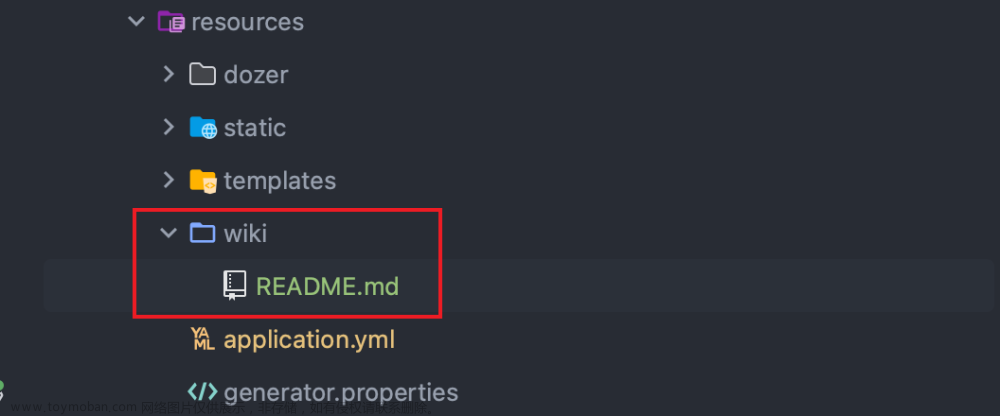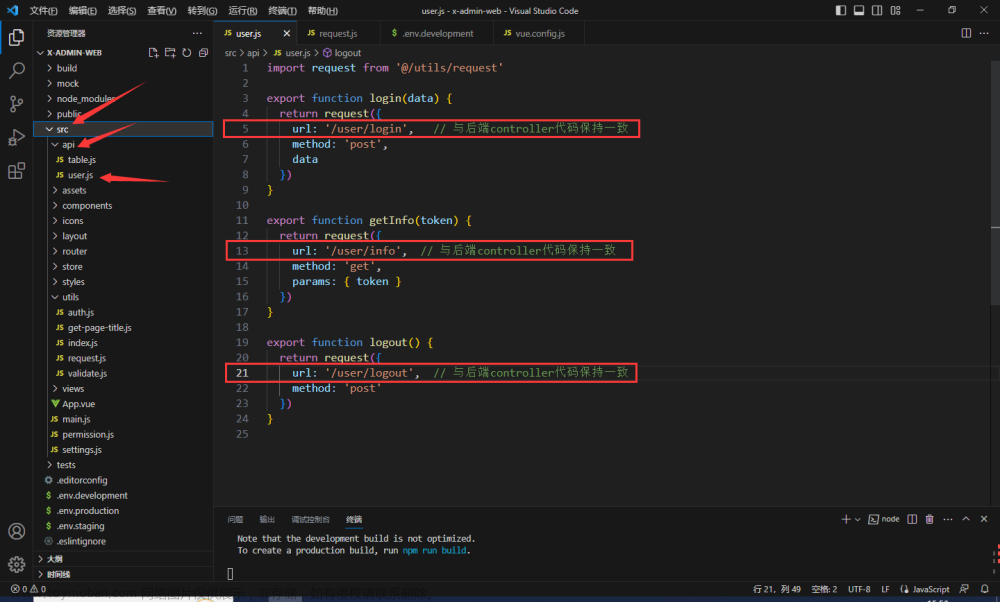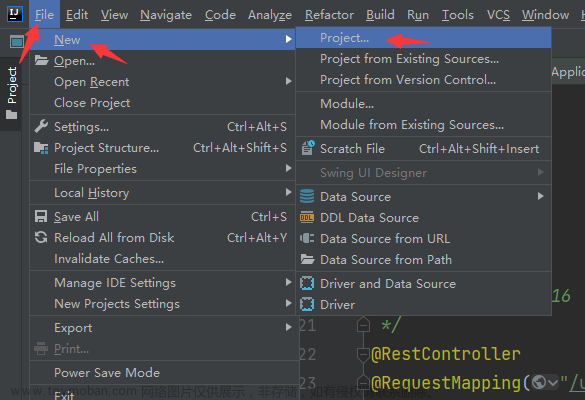Spring Boot 集成 Swagger 在线接口文档
1、Swagger 简介
1.1 解决的问题
随着互联网技术的发展,现在的网站架构基本都由原来的后端渲染,变成了前后端分离的形态,而且前端技术和后端技术在各自的道路上越走越远。前端和后端的唯一联系变成了 API 接口,所以 API 文档变成了前后端开
发人员联系的纽带,变得越来越重要。
那么问题来了,随着代码的不断更新,开发人员在开发新的接口或者更新旧的接口后,由于开发任务的繁重,往往文档很难持续跟着更新,Swagger 就是用来解决该问题的一款重要的工具,对使用接口的人来说,开发人员不需要给他们提供文档,只要告诉一个 Swagger 地址,即可展示在线的 API 接口文档,除此之外,调用接口的人员还可以在线测试接口数据,同样地,开发人员在开发接口时,同样也可以利用 Swagger 在线接口文档测试接口数据,这给开发人员提供了便利。
1.2 Swagger 官方
打开 Swagger 官网为 https://swagger.io/
主要掌握在 Spring Boot 中如何导入 Swagger 工具来展现项目中的接口文档。
2、Swagger 的 maven 依赖
使用 Swagger 工具,必须要导入 maven 依赖
<dependency>
<groupId>io.springfox</groupId>
<artifactId>springfox-boot-starter</artifactId>
</dependency>
<dependency>
<groupId>io.springfox</groupId>
<artifactId>swagger-bootstrap-ui</artifactId>
</dependency>
3、Swagger 配置
使用 Swagger 需要进行配置,Spring Boot 中对 Swagger 的配置非常方便,新建一个配置类,Swagger 的配置类上除了添加必要的@Configuration 注解外,还需要添加@EnableOpenApi 注解。
@EnableOpenApi
@Configuration
public class Swagger3Config {
@Bean
public Docket createRestApi() {
return new Docket(DocumentationType.OAS_30) // 使用 Swagger3.0 版本
// 是否关闭在线文档,生产环境关闭
.enable(true)
// 指定构建 api 文档的详细信息的方法
.apiInfo(apiInfo())
// 指定要生成 api 接口的包路径,这里把 action 作为包路径,生成 controller 中的所有接口
.apis(RequestHandlerSelectors.basePackage("com.ma.action"))
.select()
//只 有 在 方 法接口上添加了 ApiOperation 注解
.apis(RequestHandlerSelectors.withMethodAnnotation(ApiOperation.class))
.paths(PathSelectors.any()).build().globalResponses(HttpMethod.GET,
getGlobalResponseMessage())
.globalResponses(HttpMethod.POST, getGlobalResponseMessage());
}
}
// 生成摘要信息
private ApiInfo apiInfo() {
return new ApiInfoBuilder().title("接口文档") //设置页面标题
.description("说明信息") 设置接口描述
.contact(new Contact("yangyang", "http://baidu.com", "yang@yang.com")) //设置联系方式
.version("1.0") //设置版本
.build(); //构建
}
在该配置类中已经使用注释详细解释了每个方法的作用了。到此已经配置好 Swagger 了。现在可以测试一下
配置有没有生效,启动项目,在浏览器中输入 http://localhost:8080/test/swagger-ui/,即可看到 swagger 的
接口页面,说明 Swagger 集成成功。
对照 Swagger 配置文件中的配置,可以很明确的知道配置类中每个方法的作用。这样就很容易理解和掌握Swagger 中的配置了,也可以看出,其实 Swagger 配置很简单。
有可能在配置 Swagger 时关不掉,是因为浏览器缓存引起的,清空一下浏览器缓存即可解决问题。
相关配置
spring.mvc.pathmatch.matching-strategy=ANT_PATH_MATCHER
4、Swagger 的使用
已经配置好了 Swagger,并且也启动测试了一下,功能正常,下面可以开始使用 Swagger,重点要掌握 Swagger中常用的注解,分别在实体类上、Controller 类上以及 Controller 中的方法上,最后查看 Swagger 如何在页面上呈现在线接口文档的,并且结合 Controller 中的方法在接口中测试一下数据。
4.1 实体类注解
定义 User 实体类,这里主要介绍 Swagger 中的@ApiModel 和@ApiModelProperty 注解。
@ApiModel(value = "用户实体类")
public class User {
@ApiModelProperty(value = "用户唯一标识")
private Long id;
@ApiModelProperty(value = "用户姓名")
private String username;
@ApiModelProperty(value = "用户密码")
private String password;
// 省略 set 和 get 方法
}
其中@ApiModel 注解用于实体类,表示对类进行说明,用于参数用实体类接收。
@ApiModelProperty 注解用于类中属性,表示对 model 属性的说明或者数据操作更改。
4.2 Controller 类中相关注解
@RestController
@RequestMapping("/swagger")
@Api(value = "Swagger2 在线接口文档")
public class TestController {
@GetMapping("/get/{id}")
@ApiOperation(value = "根据用户唯一标识获取用户信息")
public JsonResult<User> getUserInfo(@PathVariable @ApiParam(value = "用户唯一标识") Long id) {
// 模拟数据库中根据 id 获取 User 信息
User user = new User(id, "小灰灰", "123456");
return new JsonResult(user);
}
}
1、@Api 注解用于类上,表示标识这个类是 swagger 的资源。
2、@ApiOperation 注解用于方法,表示一个 http 请求的操作。
3、@ApiParam 注解用于参数上,用来标明参数信息。
在浏览器中可以看出 Swagger 页面对该接口的信息展示的非常全面,每个注解的作用以及展示的地方注意对应位置,通过页面即可知道该接口的所有信息,那么直接在线测试一下该接口返回的信息,输入 id 为 1,看一下返回数据。
可以看出,直接在页面返回了 json 格式的数据,开发人员可以直接使用该在线接口来测试数据的正确与否,非常方便。
@PostMapping("/insert")
@ApiOperation(value = "添加用户信息")
public JsonResult<Void> insertUser(@RequestBody @ApiParam(value = "用户信息") User user) {
// 处理添加逻辑
return new JsonResult<>();
}
重启项目,然后在浏览器中输入 localhost:8080/swagger-ui.html 看效果
5、总结
主要详细分析 Swagger 的优点以及 Spring Boot 集成 Swagger,包括配置,涉及到了实体类和接口类以及如何使用。最后通过页面测试,可以体验 Swagger 的强大之处,基本上是每个项目组中必备的工具之一,所以要掌握该工具的使用。文章来源:https://www.toymoban.com/news/detail-611159.html
完整代码实现
1、pom.xml文件:
<?xml version="1.0" encoding="UTF-8"?>
<project xmlns="http://maven.apache.org/POM/4.0.0" xmlns:xsi="http://www.w3.org/2001/XMLSchema-instance"
xsi:schemaLocation="http://maven.apache.org/POM/4.0.0 https://maven.apache.org/xsd/maven-4.0.0.xsd">
<modelVersion>4.0.0</modelVersion>
<groupId>com.ma</groupId>
<artifactId>swagger</artifactId>
<version>0.0.1-SNAPSHOT</version>
<name>swagger</name>
<description>Demo project for Spring Boot</description>
<properties>
<java.version>1.8</java.version>
<project.build.sourceEncoding>UTF-8</project.build.sourceEncoding>
<project.reporting.outputEncoding>UTF-8</project.reporting.outputEncoding>
<spring-boot.version>2.6.13</spring-boot.version>
</properties>
<dependencies>
<dependency>
<groupId>org.springframework.boot</groupId>
<artifactId>spring-boot-starter-web</artifactId>
</dependency>
<dependency>
<groupId>tk.mybatis</groupId>
<artifactId>mapper-spring-boot-starter</artifactId>
<version>4.2.2</version>
</dependency>
<dependency>
<groupId>org.projectlombok</groupId>
<artifactId>lombok</artifactId>
<scope>provided</scope>
</dependency>
<dependency>
<groupId>org.springframework.boot</groupId>
<artifactId>spring-boot-starter-test</artifactId>
<scope>test</scope>
</dependency>
<!-- 在线文档的支持 -->
<dependency>
<groupId>io.springfox</groupId>
<artifactId>springfox-boot-starter</artifactId>
<version>3.0.0</version>
</dependency>
<dependency>
<groupId>com.github.xiaoymin</groupId>
<artifactId>swagger-bootstrap-ui</artifactId>
<version>1.9.6</version>
</dependency>
</dependencies>
<dependencyManagement>
<dependencies>
<dependency>
<groupId>org.springframework.boot</groupId>
<artifactId>spring-boot-dependencies</artifactId>
<version>${spring-boot.version}</version>
<type>pom</type>
<scope>import</scope>
</dependency>
</dependencies>
</dependencyManagement>
<build>
<plugins>
<plugin>
<groupId>org.apache.maven.plugins</groupId>
<artifactId>maven-compiler-plugin</artifactId>
<version>3.8.1</version>
<configuration>
<source>1.8</source>
<target>1.8</target>
<encoding>UTF-8</encoding>
</configuration>
</plugin>
<plugin>
<groupId>org.springframework.boot</groupId>
<artifactId>spring-boot-maven-plugin</artifactId>
<version>${spring-boot.version}</version>
<configuration>
<mainClass>com.ma.SwaggerApplication</mainClass>
<skip>true</skip>
</configuration>
<executions>
<execution>
<id>repackage</id>
<goals>
<goal>repackage</goal>
</goals>
</execution>
</executions>
</plugin>
</plugins>
</build>
</project>
2、application.properties文件
# 应用服务 WEB 访问端口
server.port=8080
# swagger相关的一个路径匹配规则的配置,如果不进行配置则无法访问到swagger的页面
spring.mvc.pathmatch.matching-strategy=ANT_PATH_MATCHER
3、SwaggerApplication文件:
package com.ma;
import org.springframework.boot.SpringApplication;
import org.springframework.boot.autoconfigure.SpringBootApplication;
import org.springframework.boot.autoconfigure.jdbc.DataSourceAutoConfiguration;
@SpringBootApplication(exclude = DataSourceAutoConfiguration.class)
public class SwaggerApplication {
public static void main(String[] args) {
SpringApplication.run(SwaggerApplication.class, args);
}
}
4、创建一个action的包在包内创建HelloController.java文件:
package com.ma.action;
import com.ma.domain.JsonResult;
import io.swagger.annotations.*;
import org.springframework.web.bind.annotation.GetMapping;
import org.springframework.web.bind.annotation.RequestMapping;
import org.springframework.web.bind.annotation.RequestParam;
import org.springframework.web.bind.annotation.RestController;
@Api(tags="测试控制器")
@RestController
@RequestMapping("/test")
public class HelloController {
@ApiOperation("问候语测试")
@GetMapping("/hello")
@ApiImplicitParams({
@ApiImplicitParam(dataType = "string",name = "username",value = "用户登录账号",required = true),
@ApiImplicitParam(dataType = "string",name = "password",value = "用户登录密码",required = false,defaultValue = "666666")
})
public JsonResult hello(@ApiParam("用户名称") @RequestParam(value="username",required =true) String name){
String res = "hello" + name + "!";
return JsonResult.success("处理完毕",res);
}
}
5、创建一个conf的包在包内创建Swagger3Config.java文件:
package com.ma.conf;
import io.swagger.models.HttpMethod;
import org.springframework.context.annotation.Bean;
import org.springframework.context.annotation.Configuration;
import springfox.documentation.builders.ApiInfoBuilder;
import springfox.documentation.builders.PathSelectors;
import springfox.documentation.builders.RequestHandlerSelectors;
import springfox.documentation.oas.annotations.EnableOpenApi;
import springfox.documentation.service.ApiInfo;
import springfox.documentation.service.Contact;
import springfox.documentation.spi.DocumentationType;
import springfox.documentation.spring.web.plugins.Docket;
@EnableOpenApi
@Configuration
public class Swagger3Config {
/**
* 创建API应用
* apiInfo() 增加API相关信息
* 通过select()函数返回一个ApiSelectorBuilder实例,用来控制哪些接口暴露给Swagger来展现,
* 本例采用指定扫描的包路径来定义指定要建立API的目录。
* swagger测试地址:http://localhost:8080/swagger-ui/index.html#/
* @return
*/
@Bean
public Docket createRestApi() {
return new Docket(DocumentationType.OAS_30) // 使用Swagger3.0版本
.enable(true)// 是否关闭在线文档,生产环境关闭
.apiInfo(apiInfo()) // 指定构建api文档的详细信息的方法
.select() // 指定要生成api接口的包路径,这里把action作为包路径,生成controller中的所有接口
.apis(RequestHandlerSelectors.basePackage("com.ma.action"))
// .apis(RequestHandlerSelectors.withMethodAnnotation(ApiOperation.class))方法接口上添加了ApiOperation注解
.paths(PathSelectors.any()).build()
//针对应用的全局响应消息配置
// .globalResponses(HttpMethod.GET, getGlobalResponseMessage())
// .globalResponses(HttpMethod.POST, getGlobalResponseMessage())
;
}
/**
* 创建该API的基本信息(这些基本信息会展现在文档页面中)
* 访问地址:http://项目实际地址/swagger-ui.html
* @return
*/
private ApiInfo apiInfo() {
return new ApiInfoBuilder()
.title("接口文档") //设置页面标题
.description("说明信息") //设置接口描述
.contact(new Contact("mayang", "http://baidu.com", "ma@ma.com")) //设置联系方式
.version("1.0") //设置版本
.build(); //构建
}
}
6、创建一个domain的包在包内创建JsonResult.java文件:
package com.ma.domain;
import io.swagger.annotations.ApiModel;
import io.swagger.annotations.ApiModelProperty;
import lombok.Data;
import java.io.Serializable;
@Data
@ApiModel("针对前端的响应数据格式规范")
public class JsonResult implements Serializable {
@ApiModelProperty("是否处理成功,布尔类型数据")
private Boolean success;
@ApiModelProperty("响应消息信息,字符串类型")
private String message;
@ApiModelProperty("响应数据,对象类型")
private Object data;
public static JsonResult success(String message, Object data) {
JsonResult res=new JsonResult();
res.setMessage(message);
res.setSuccess(true);
res.setData(data);
return res;
}
}
7、启动程序后可以通过访问地址http://localhost:8080/swagger-ui/index.html来对swagger网站进行操作
 文章来源地址https://www.toymoban.com/news/detail-611159.html
文章来源地址https://www.toymoban.com/news/detail-611159.html
到了这里,关于SpringBoot集成 Swagger的文章就介绍完了。如果您还想了解更多内容,请在右上角搜索TOY模板网以前的文章或继续浏览下面的相关文章,希望大家以后多多支持TOY模板网!











